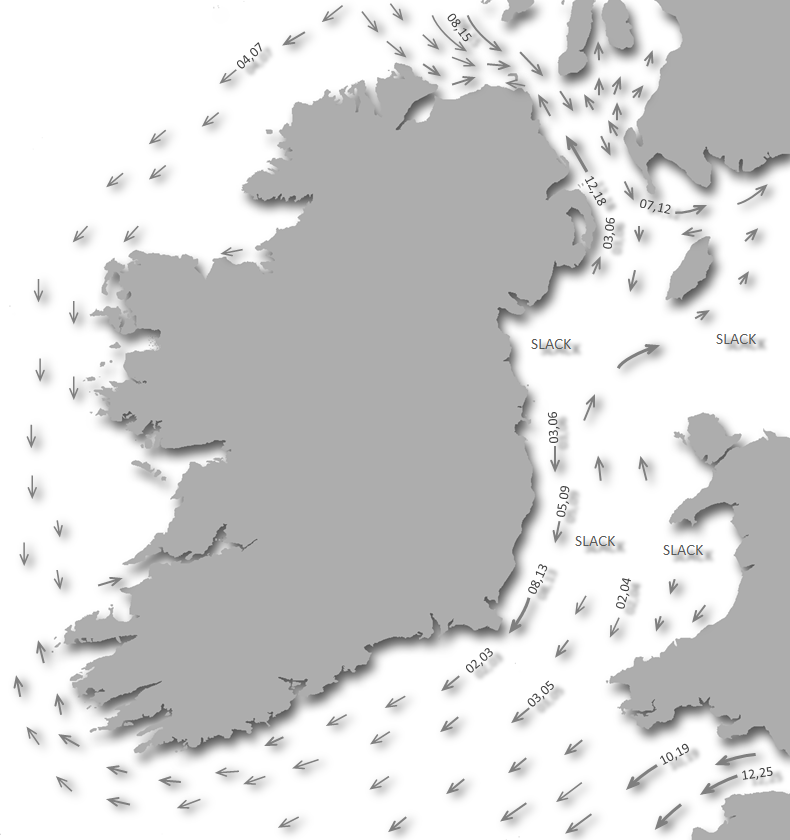
The bay is completely open to westerly conditions and exposed to the Atlantic swell. It provides an exposed anchorage in offshore winds northeast around through east to southwest, or in very settled conditions. Access is straightforward as the bay is entirely open with no off-lying dangers.
Keyfacts for Fanore Bay
Facilities




Nature






Considerations
Protected sectors
Approaches


Shelter


Last modified
May 17th 2018 Summary
An exposed location with straightforward access.Facilities




Nature






Considerations
Position and approaches
Expand to new tab or fullscreen
Haven position
 53° 7.150' N, 009° 18.000' W
53° 7.150' N, 009° 18.000' WThis is about quarter of a mile off the shoreline and in the centre of the bay with 10 metres of water.
What is the initial fix?
The following Fanore Bay initial fix will set up a final approach:
 53° 7.150' N, 009° 18.820' W
53° 7.150' N, 009° 18.820' W What are the key points of the approach?
Offshore details are available in western Ireland’s Coastal Overview for Loop Head to Slyne Head  .
.
 .
.Not what you need?
Click the 'Next' and 'Previous' buttons to progress through neighbouring havens in a coastal 'clockwise' or 'anti-clockwise' sequence. Below are the ten nearest havens to Fanore Bay for your convenience.
Ten nearest havens by straight line charted distance and bearing:
- Ballyvaughan Bay - 5.5 nautical miles E
- Doolin Pier (Ballaghaline Quay) - 7.3 nautical miles SSW
- Spiddle - 7.4 nautical miles N
- Aughinish Bay - 8.4 nautical miles ENE
- Inisheer - 8.6 nautical miles WSW
- Caladh Mór Pier - 10.2 nautical miles W
- Liscannor Bay - 11.3 nautical miles SSW
- Kinvara Bay - 12.4 nautical miles ENE
- Galway Docks - 12.8 nautical miles NE
- Rossaveel - 12.9 nautical miles NW
These havens are ordered by straight line charted distance and bearing, and can be reordered by compass direction or coastal sequence:
- Ballyvaughan Bay - 5.5 miles E
- Doolin Pier (Ballaghaline Quay) - 7.3 miles SSW
- Spiddle - 7.4 miles N
- Aughinish Bay - 8.4 miles ENE
- Inisheer - 8.6 miles WSW
- Caladh Mór Pier - 10.2 miles W
- Liscannor Bay - 11.3 miles SSW
- Kinvara Bay - 12.4 miles ENE
- Galway Docks - 12.8 miles NE
- Rossaveel - 12.9 miles NW
Chart
How to get in?
 Fanore Bay
Fanore BayImage: cunjo via CC BY-SA 2.0
Fanore Point lies 1¾ miles southwestward of Black Head and Fanore Bay lies immediately to the south. The bay can be identified by its long beach backed by an extensive range of sand dunes. Vessels may anchor here with offshore winds about a ¼ of a mile from the strand in a depth of 10 metres. Should the wind be blowing hard from the east it might be preferable to remain here than to attempt to beat up Galway Bay.
 The initial fix sets up a recommended easterly approach into the anchorage for half a mile. However, there are no off-lying dangers off this coastal area. As such the initial fix does not have to be strictly adhered to and it is safe to approach the beach at angles.
The initial fix sets up a recommended easterly approach into the anchorage for half a mile. However, there are no off-lying dangers off this coastal area. As such the initial fix does not have to be strictly adhered to and it is safe to approach the beach at angles.  Sound in, and anchor in sand according to requisite draught and desired safety margins of water. Land by dinghy on the beach if conditions permit.
Sound in, and anchor in sand according to requisite draught and desired safety margins of water. Land by dinghy on the beach if conditions permit.Why visit here?
Fanore’s name is derived from the Irish Fan Oir, meaning the ‘golden slope’. Although named after its golden sandy beach, it is famous for the weathered ‘Burren’ limestone plateaus that slope down to the shore here, and for it views out over the Aran Islands and Galway Bay. The Burren Karst Landscape
The Burren Karst LandscapeImage: Tourism Ireland
Today the area is popular with caravan dwellers who enjoy swimming, fishing and surfing off the spectacular golden beach which is streaked by grey erosion of its Burren rock. But these were not the first people to live among the Fanore’s extensive sandhills. Stone Age men were here first and their house sites and kitchen middens, old dumps for domestic waste, can still be found in the immediate area. In fact, the entire Burren area is rich in archaeology with over 500 ring forts and over 80 known Neolithic tombs.
This sense of history can be appreciated by following the Caher River which is the only ‘Burren’ river to run along the surface from its source to the sea. The mouth of the river can be found ashore separating the sandy beach to the south from the rocky beach to the north. It leads to the Caher Valley that in past times hosted a number of Celtic ‘ring-forts’, in Irish Cahers, and both the river and the valley were named as such.
 The Green Roads
The Green RoadsImage: Tourism Ireland
A more welcome legacy of the tragedy are ‘The Green Roads’ that cut along the side of the hills throughout this area. These follow tracks that have been in continual use since early times. Some of these were built as relief projects during the dark days of the famine.
Today these walks are enormously popular attracting walkers and botanists from all over the world to stroll in splendid isolation through the world famous Burren to which Fanore offers a central entry point. The Burren, derived from the Irish word Boireann, meaning "great rock", is a lunar-like karst-landscape region. The rock area measures approximately 250 square kilometres and is one of the largest karst-landscape in Europe. Renowned for its unique flora and fauna The Burren hosts a spectacular array of over 70% of Ireland’s native flora. The hills here also teem with geological oddities such as labyrinthine cave systems, disappearing streams and lakes, tiered hillsides and oddly dissected pavements. Today a small portion of this has been designated as Burren National Park and it ranks amongst one of Ireland’s unique experiences.
 Poulnabrone Dolmen, The Burren
Poulnabrone Dolmen, The BurrenImage: Tourism Ireland
From a boating perspective, Fanore’s prime attraction is a wind-wait location to enter Galway Bay. Should the wind be blowing hard from the east it might be preferable to remain here than to attempt to beat up the bay. However, there is plenty here to attract a shore party in the right conditions.
What facilities are available?
There is nothing at this remote beach. Fanore village, actually Craggagh, has a Post Office, shop and bar that is the commercial centre of this rambling, scattered community. The local pub provides traditional entertainment and serves good food.Fanore is an hour by car from the city of Galway, an hour and a half from the city of Limerick and just over an hour from Shannon International Airport.
Any security concerns?
Never an issue known to have occurred to a vessel anchored in Fanore Bay.With thanks to:
Mark Murray, Yacht Motivator.Add your review or comment:
Please log in to leave a review of this haven.
Please note eOceanic makes no guarantee of the validity of this information, we have not visited this haven and do not have first-hand experience to qualify the data. Although the contributors are vetted by peer review as practised authorities, they are in no way, whatsoever, responsible for the accuracy of their contributions. It is essential that you thoroughly check the accuracy and suitability for your vessel of any waypoints offered in any context plus the precision of your GPS. Any data provided on this page is entirely used at your own risk and you must read our legal page if you view data on this site. Free to use sea charts courtesy of Navionics.












